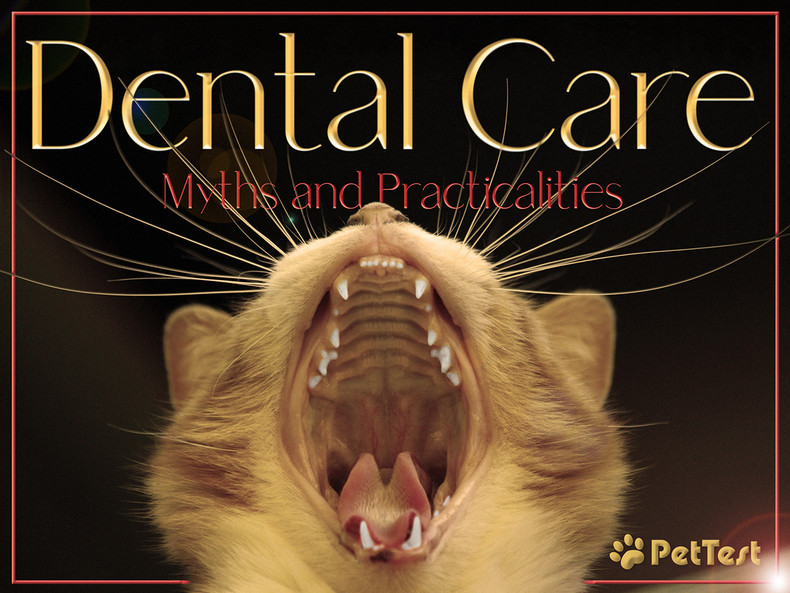Dental Care for Kitty - Myths and Practicalities
I am not a fan of dental work or anything related including my own dentist who I called “evil” the last time I had major dental work done – sedatives were involved but still, I have been admittedly an on-and-off girl when it comes to dental visits my entire life. However, when I had a cavity and then saw a video on root canals, I have not missed a cleaning appointment since. This is very motivating for a human anyway.
Kitty does not brush regularly – unless you start doing it when they are kittens and get them used to it, chances are very good that Kitty has developed some sort of periodontal issues which can range from a little bit of plaque and tarter to loose/missing teeth or even infection. I have never been able to brush any of my pets’ teeth younger or older. Young kittens and puppies think it is play or snack time, but I have heard this technique is actually possible and can prevent issues down the road. (Good luck with that, and if you have been successful, please share!)
Myth: My kitty eats low-carb dry food and treats so their teeth are getting some cleaning. I always though this too; however, consider how your human teeth feel after having a crunchy food item like crackers, chips, or something like hard granola. Do they feel clean? Also consider all the little crunched bits hanging out between the so-called clean teeth. Granted, food with friction is going to preserve the bone and muscle structure of tooth and jaw to a point from the sheer exercise of crunching. Dry food and treats will not, however, prevent plaque, tarter, or cavities in Kitty any better than it would for humans (I’d be living on solely crunchy foods myself if this were the case!)
Myth: If pets needed dentists, there would be regular pet dentists. Another trip to a separate chamber of horrors just for kitty’s teeth! I honestly believe if I did that, my cats would team up - probably with the dogs - ambush me, get me down, and find creative ways to torture me for revenge. Your regular vet should be checking oral health at every well visit. There ARE specialty pet dentists for animals with severe periodontal disease or high risk animals such as uncontrolled diabetes, geriatric animals, and other more complicated oral health issues that your dentist may not feel qualified for. The American Veterinary Dental College has a great page on animal-owner resources, veterinary lists, and a lot of information should you find Kitty needs referred to a dental specialist.
Myth: Since brushing was not possible and the crunchy food claim is wrong, there is nothing I can do to prevent kitty having severe dental problems. There are products considered “plaque retardant.” There are foods and many other products that can help prevent and sometimes correct some periodontal issues. There is a council that certifies products for dental care for both cats and dogs, Veterinary Oral Health Council . They have a quite strict list of requirements to receive the use of their approved label, which means a short list.
Practicalities: Talking to your vet about regular dental care is a good first step. If Kitty is not going to put up with brushing, there are sprays and other alternatives. You will need to study the ingredients as you do their food to check for hidden carbs and sugars. There are a host of supplements and essential oils that make claims to reverse plaque and tartar buildup. It is extremely important to discuss any considerations with your vet. What may be a wonderful homeopathic tooth care regimen for a normal cat, may have naturally occurring sugars or other elements that will cause other problems. If you want to look into homeopathic remedies for kitty, AnimalEO has a lot of research. The owner is an actual vet, and you can ask questions (and actually get an answer), as well as get sample sizes to try. You can read about experiences, creative dental care ideas, and get practical help on the Feline Diabetic Support Group on FB.
While pearly whites do not seem to be high on the priority list when you are testing, dosing insulin, trying to get Kitty into remission, and, frankly, just get through the day, it is a good idea to take a look for signs of dental problems. I can usually lift up their lips to inspect the outside of their teeth and gums if they are sound asleep. Yellow is usually plaque if on the tooth. Tartar is the hard stuff the dentist has to scrape off and can be dark yellow to brown in color. Bleeding or swelling gums care an indication of inflammation of the gums and periodontal disease. If you can get a sniff, and smell any type of garbage scent or rot, it is time to see your vet for treatment as soon as possible.
Even with the best dental care regimen from kitten-hood, it is almost inevitable that a cavity will develop, a tooth will be lost, or tarter and plaque will build up somewhere. The same is true for us humans. The difference is Kitty gets lovely sedation for a thorough dental cleaning, while we humans are forced to tough it out.

